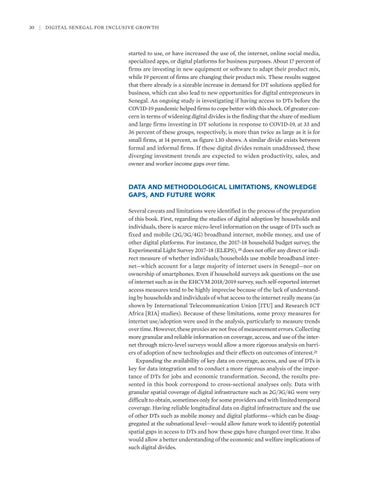30
| Digital Senegal for Inclusive Growth
started to use, or have increased the use of, the internet, online social media, specialized apps, or digital platforms for business purposes. About 17 percent of firms are investing in new equipment or software to adapt their product mix, while 19 percent of firms are changing their product mix. These results suggest that there already is a sizeable increase in demand for DT solutions applied for business, which can also lead to new opportunities for digital entrepreneurs in Senegal. An ongoing study is investigating if having access to DTs before the COVID-19 pandemic helped firms to cope better with this shock. Of greater concern in terms of widening digital divides is the finding that the share of medium and large firms investing in DT solutions in response to COVID-19, at 33 and 36 percent of these groups, respectively, is more than twice as large as it is for small firms, at 14 percent, as figure 1.10 shows. A similar divide exists between formal and informal firms. If these digital divides remain unaddressed, these diverging investment trends are expected to widen productivity, sales, and owner and worker income gaps over time.
DATA AND METHODOLOGICAL LIMITATIONS, KNOWLEDGE GAPS, AND FUTURE WORK Several caveats and limitations were identified in the process of the preparation of this book. First, regarding the studies of digital adoption by households and individuals, there is scarce micro-level information on the usage of DTs such as fixed and mobile (2G/3G/4G) broadband internet, mobile money, and use of other digital platforms. For instance, the 2017–18 household budget survey, the Experimental Light Survey 2017–18 (ELEPS), 28 does not offer any direct or indirect measure of whether individuals/households use mobile broadband internet—which account for a large majority of internet users in Senegal—nor on ownership of smartphones. Even if household surveys ask questions on the use of internet such as in the EHCVM 2018/2019 survey, such self-reported internet access measures tend to be highly imprecise because of the lack of understanding by households and individuals of what access to the internet really means (as shown by International Telecommunication Union [ITU] and Research ICT Africa [RIA] studies). Because of these limitations, some proxy measures for internet use/adoption were used in the analysis, particularly to measure trends over time. However, these proxies are not free of measurement errors. Collecting more granular and reliable information on coverage, access, and use of the internet through micro-level surveys would allow a more rigorous analysis on barriers of adoption of new technologies and their effects on outcomes of interest.29 Expanding the availability of key data on coverage, access, and use of DTs is key for data integration and to conduct a more rigorous analysis of the importance of DTs for jobs and economic transformation. Second, the results presented in this book correspond to cross-sectional analyses only. Data with granular spatial coverage of digital infrastructure such as 2G/3G/4G were very difficult to obtain, sometimes only for some providers and with limited temporal coverage. Having reliable longitudinal data on digital infrastructure and the use of other DTs such as mobile money and digital platforms—which can be disaggregated at the subnational level—would allow future work to identify potential spatial gaps in access to DTs and how these gaps have changed over time. It also would allow a better understanding of the economic and welfare implications of such digital divides.



